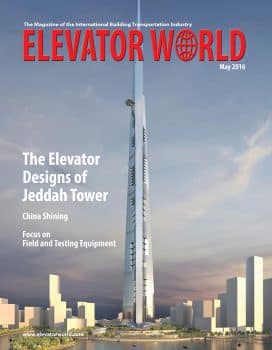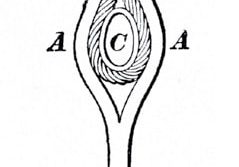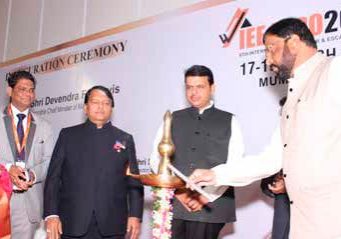The Harrison family
May 1, 2016

Texas family has been in the elevator industry for five generations and is working on a sixth.
Five generations of the Harrison family have worked in the elevator industry with some version of the same company where their forefather was one of the first employees, the Hunter-Hayes division of Dover Elevator, which began in turn-of-the-century Dallas. Members of the generation who are working now have every intention of continuing the tradition.
ELEVATOR WORLD recently spoke with members of the family, who, along with members of the Hunter, Hayes and Burke families, have histories interwoven with those of the Southwest, the nation and the world. Observes Leslie Harrison Pollard, a member of the fifth generation who is an account manager at thyssenkrupp’s downtown Dallas office: “Thanksgiving or Christmas with the Harrison side of the family is nothing short of an elevator convention!”
Her brother, Luke, is also a thyssenkrupp account manager in Fort Worth, and her cousin, Paul Harrison, is the creative director for marketing for the thyssenkrupp Americas business unit in Frisco, Texas. Another brother, Collin, went on to become vice president of Finance and Information Technology at Alliance Data Systems (a company that handles digital marketing for major players such as Walgreens and Pottery Barn) after spending several years with thyssenkrupp’s Soundnet division.
Their parents are the children of George H. “Bill” Harrison, Jr., a third-generation elevator professional who began working for Hunter-Hayes in 1943. Harrison, Jr.’s sons were Jack Harrison, who joined the company building controllers in 1967 alongside Jim Poston and Richard Knott, Tom Harrison, father of Leslie, Luke and Collin, and Bill (Billy Paul) Harrison, father of Paul, who came to work for Hunter-Hayes in the mid 1960s in Engineering. At the time, the company had nearly two dozen offices throughout the region.
Billy Paul Harrison was the oldest son of George “Bill” Harrison, Jr., and the first to follow in his father’s footsteps in the trade. He started his career working in construction at Hunter-Hayes as a helper in the summer of 1962. He continued his career in the union for 12 years as an adjuster and, in 1974, went to work for the General Services Administration (GSA) as an elevator inspector and consultant. He ended his career with thyssenkrupp as a national account manager in 2013. Billy Paul Harrison’s son, Paul, tells this story about his dad:
“When I was around 10 years old, I remember by dad, Bill, taking me with him to troubleshoot elevators. One job in particular stands out – one that had old traction DC gearless machines that required you to climb all these stairs and a ship ladder to gain access to the machine room. At the time, I thought to myself, ‘Wow, there sure is a lot of stair climbing in the elevator business.’ Once we made it to the machine room, it was hot, noisy and dirty (from the carbon brushes on the generators). Then we stood for what seemed like hours in front of this big, blue box that made these clicking noises every time the elevator would run.
“I couldn’t understand why we had to stand there so long while he stared at the box (an old relay logic controller). I remember thinking to myself, ‘If this is what the elevator business is all about, then no thank you.’ That was until I rode on the car top and got to see the gearless elevators traveling by me in the hoistway, see it stop so smoothly at the floor above us, cycle its doors and take off again. Then I knew there was something special about this industry that not too many people in the world get to experience. As I grew, the more I realized how critical elevators are to our urbanizing world and am very proud to be part of a family that has been involved since they were invented.”
After years with Hunter-Hayes and GSA, Jack Harrison joined UT Southwest Medical Center in Dallas and became head of its elevator group, retiring in 2006. Today, Jack and Billy Paul are retired and spend a lot of time traveling, golfing and spending time with family and friends.
Tom Harrison started out working in the Hunter-Hayes shop building door operators during the summers with his uncle, Leon Pannell. Tom Harrison also served in Vietnam after graduating high school in the 1960s, and three other Harrison family generations served their country. After he returned from Vietnam, he rejoined the family firm and continued to work there for many years until he branched out on his own in the elevator trade.
Leslie, Luke, Collin and Paul Harrison have a total of 13 children, and they feel that at least some of them will join the industry one day, following in the footsteps of the first Harrison in the business – Jacob R. “Jake” Harrison, who was the first field mechanic for a firm founded by J. Peyton Hunter, Sr., on Dallas’ Main Street in 1902. Jake Harrison stayed with the company until his retirement in 1939.
In the Harrison family, careers start early, with high-school students spending summers working in elevator offices with their older relatives. Pollard’s father, Tom Harrison, who today uses his nearly five decades of experience as a consultant specializing in expert witness testimony, says that it is the way to go:
“If, when you get out of high school, you get the opportunity to go work in an elevator office, do it. You will gain an understanding of how elevator systems and companies work, and later, when you get an opportunity to work as a salesperson or ad executive, that experience will show, and it will set you apart as a candidate.”
Tom Harrison co-invented the Adams HatchLatch® in the mid 2000s (with Greg Horne). The ASME A17.1-compliant device, which keeps elevator doors securely locked between landings, has been updated at least five times over the years.
Tom Harrison said his dad instilled in him and his brothers an independent, problem-solving spirit. He recalls:
“He would never hesitate to let you work ‘far over your head.’ One of his favorite things to say in response to questions about how something worked was, ‘You’ve got to figure it out for yourself. Understand the logic behind it, and go solve the problem.’ That attitude helped make me what I am today.”
For many young elevator-industry professionals, Tom Harrison says, that attitude is missing. With technological advancement has come the tendency to rely on computer programs to solve problems. With laptop or tablet at the ready, today’s professional often simply plugs in his or her device and uses a diagnostic tool to determine the course of action to address equipment issues. It usually works, of course, but as a result, they lack the in-depth understanding of vertical-transportation systems their predecessors possessed.
For many years, Tom, Jack and Billy Paul’s father, George H. “Bill” Harrison, Jr., worked in Hunter-Hayes’ Construction department under Henry F. Tobe, a colorful gentleman who came to work for the company in 1927, eventually working his way up to Construction superintendent, and about whom many stories were told. Tom Harrison said he heard from his dad that “Tobe would get so irritated he’d fire a person on Friday and hire them back on a Monday, just because he felt sorry for them. He was a real character.”
A family history elaborates about Tobe, who retired in 1966:
“He could always give you almost any information you needed about any job installed under his supervision – the type of equipment installed, how many units, etc. Of course, he always had stories to go with the information about the good times experienced by his employees.”
The growth of the company through the years reflected what was going on in the region, nation and world at the time. Hunter-Hayes, in fact, became Hunter-Hayes as a result of the construction boom that began in the Southeast starting in approximately 1920. It drove significant expansion of the company and led J. Peyton Hunter to bring in a brother-in-law, George W. Hayes, Sr., to form Hunter-Hayes. A turning point came in 1930, when the company was awarded what, at the time, was the largest elevator contract west of the Mississippi River. The approximately US$350,000 (close to US$5 million in today’s dollars) contract entailed installation of 21 passenger and freight elevators with gearless General Electric machines at the Texas & Pacific Railway Terminal office and warehouse in Fort Worth, Texas, an architectural jewel that showcases the Gatsbyesque “Zigzag Moderne” Art Deco style of the time.
After George W. Hayes, Sr., passed away in 1937, his son, George W. “Peeper” Hayes, Jr., was an integral part of the growth of the Texas Medical Center in Houston. He oversaw many installations there, and did not retire until 1971. Before and during World War II, business consisted primarily of elevator installations at defense and munitions facilities throughout the Southwest.
Dover Elevator, at the time among the top U.S. elevator companies, purchased Hunter-Hayes in 1964 in an effort to strengthen its position in the electric elevator business. thyssenkrupp acquired the Hunter-Hayes division of Dover in 1999, and Pollard observes it has been a great company for which to work. She states:
“The elevator industry is such a unique trade, and it’s a great thing to work around people you feel are your own family. It’s an honor to know your forefathers worked in the trade from the time of the startup of Hunter-Hayes and to then have grandfathers, uncles and dads who served many years during the Dover era.”
Her father and uncles agree. Jack Harrison opines: “I often think about teachers that ask their students what they want to be when they grow up. I think you would have to look long and hard to find a student who says ‘elevator man, or woman,’ for that matter. Way to go, Leslie!”
Get more of Elevator World. Sign up for our free e-newsletter.








